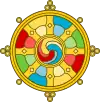Changkya Khutukhtu
The Changkya Khutukhtu (Chakhar Mongolian: Janggiy-a qutuγ-tu, Khalkha Mongolian: Зангиа Хутагт Zangia Khutagt; Tibetan: ལྕང་སྐྱ་ཧོ་ཐོག་ཐུ།, lcang-skya ho-thog-thu; Chinese: 章嘉呼圖克圖, Zhāngjiā Hūtúkètú) was the title held by the spiritual head of the Gelug lineage of Tibetan Buddhism in Inner Mongolia during the Qing dynasty.
| Part of a series on |
| Tibetan Buddhism |
|---|
 |
The most important lama of this series was the Third Changkya, Rolpai Dorje, who was preceptor to the Qianlong emperor of China, and chief representative of Tibetan Buddhism at the Qing court. He and his successors, mostly based in Beijing, were considered to be the senior Tibetan lamas in China proper and Inner Mongolia. The Seventh Changkya accompanied the Nationalist government to Taiwan in 1949 and died there in 1957.[1]
List of lCang-skya Khutukhtu
Note: In some enumerations, the second Changkya, Ngawang Losang Chöden is counted as the first, the third Rölpé Dorjé as the second, and so on.[1]
- 1607-1641: Changkya Dragpa Öser (lcang skya grags pa 'od zer)[2]
- 1642-1714: Changkya Ngawang Losang Chöden (lcang skya ngag dbang bLo bzang chos ldan)[3]
- 1717-1786: Changkya Rölpé Dorjé[4][5][6][7] (lcang skya rol pa'i rdo rje)[8]
- 1787-1846: Changkya Yéshé Tenpé Gyeltsen (lcang skya ye shes bstan pa'i rgyal mtshan)[9]
- 1849-1875: Changkya Yéshé Tenpé Nyima (lcang skya ye shes bstan pa'i nyi ma)[10]
- 1878-1888: Changkya Lozang Tendzin Gyeltsen (lcang skya blo bzang bstan 'dzin rgyal mtshan)[11]
- 1891-1957: Changkya Lozang Penden Tenpé Drönmé (lcang skya blo bzang dpal ldan bstan pa'i sgron me)[12]
- 1980- : Changkya Tendzin Dönyö Yéshé Gyatso (bstan 'dzin don yod ye shes rgya mtsho)[13]
The previous lCang-skya Khutukhtu, named Lozang Penden Tenpé Drönmé, went to Taiwan in 1949.[14] It has been reported that before his death in 1957 he had signed a pledge that he would not reincarnate until the Republic of China retook the mainland.[15] However, the Dalai Lama recognised the current incarnation on 11 August 1998. He was born in 1980 in Tsongkha region, was ordained at an early age and came to India as a refugee in 1998. He is now residing in the re-established Drepung Monastery, in India.[16] Neither he nor two other claimants to be the current Changkya[1] are recognised by either Taipei or Peking.[15]
References
Citations
- Samuel, Geoffrey (2012). Introducing Tibetan Buddhism. Introducing World Religions. Abingdon: Routledge. p. 249. ISBN 978-0-415-45664-7.
- grags pa 'od zer
- ngag dbang blo bzang chos ldan
- The Third Changkya, Rolpai Dorje
- Dalai Lama about Rolpe Dorje Archived October 3, 2009, at the Wayback Machine
- "Rölpai Dorje — Teacher of the Empire". Archived from the original on 2008-09-28. Retrieved 2009-08-26.
- Traditional Guidelines for Translating Buddhist Texts
- rol pa'i rdo rje
- ye shes bstan pa'i rgyal mtshan
- ye shes bstan pa'i nyi ma
- blo bzang bstan 'dzin rgyal mtshan
- blo bzang dpal ldan bstan pa'i sgron me
- bstan 'dzin don yod ye shes rgya mtsho
- 藏傳佛教在台灣的發展 Archived July 8, 2010, at the Wayback Machine
- 达赖喇嘛确立的第20世章嘉活佛访问日本 (20th Changkya as recognised by Dalai Lama visits Japan), Radio Free Asia, 2017-03-01
- Lcang skya rin po che'i sku phreng rim byon gyi ngo sprod rags bsdus // Bod kyi dus bab, 20 October 1998:3. See Kevin Garratt, "Biography by installment: Tibetan language reportage on the lives of reincarnate lamas", 1995-99; in P. Christiaan Klieger, Tibet, self, and the Tibetan diaspora: voices of difference ; PIATS 2000: Tibetan studies: proceedings of the ninth seminar of the International Association for Tibetan Studies (Leiden 2000). P. 89-90.
Sources
- Smith, E. Gene (2001). 'The Life of Lcang skya Rol pa'i rdo rje' in Among Tibetan Texts Boston. Somerville: Wisdom Publications. pp. 133–146. ISBN 0-86171-179-3.
- Sullivan, Brenton (2013). The Mother of All Monasteries: Gönlung Jampa Ling and the Rise of Mega Monasteries in Northeastern Tibet (Ph.D.). University of Virginia.